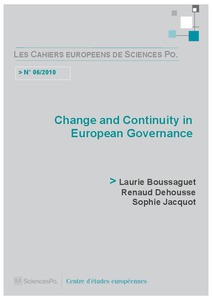Change and continuity in European governance
"Since the mid 1990s, European governance has evolved substantially, particularly in the direction of fewer constraints: flexibility, coordination, peer monitoring, and soft law have become fashionable themes. The literature on “new modes of governance” (or NMGs) has flourished alongside these...
| Main Authors: | , , |
|---|---|
| Institution: | ETUI-European Trade Union Institute |
| Format: | TEXT |
| Language: | English |
| Published: |
Paris
2010
Centre d'études européennes de Sciences Po |
| Subjects: | |
| Online Access: | https://www.labourline.org/KENTIKA-19136459124919546319-Change-and-continuity-in-europ.htm |
| Summary: | "Since the mid 1990s, European governance has evolved substantially, particularly in the direction of fewer constraints: flexibility, coordination, peer monitoring, and soft law have become fashionable themes. The literature on “new modes of governance” (or NMGs) has flourished alongside these transformations. But is the existence of “new” instruments of governance necessarily synonymous with an innovative way of doing things? Is it really the case that NMGs now play a central role in EU policy-making? Are we witnessing the emergence of an entirely new system of governance at the European level? In order to address these questions, this paper begins by briefly making the point that the concept of governance is better suited to describing the way public policy is conducted in the European Union, than that of government. It then moves to a discussion of the main trends that are identified as NMGs in order to assess to what extent they can properly be described as “new”. This is followed by an overview of more traditional forms of EU action, which shows that “old” governance has far from disappeared.
The European system of governance is thus a good example of change in continuity: “old” and “new” are not mutually exclusive and this hybrid situation may in part be due to the great contiguity that exists between new modes of governance and their forerunners. New modes of governance are best analysed as an accentuation of the original features of the system, rather than as outright innovations. Both were largely conceived to respond to the same need, to provide a framework for interstate cooperation without leading to an unwanted degree of centralisation. This is not without analogy with the metaphor of the “marble cake”, used over a century ago by Morton Grodzins to describe the coexistence of several varieties of federalism in American government. Pure innovations are rare in the world of governance." |
|---|---|
| Physical Description: | 22 p. Digital |

